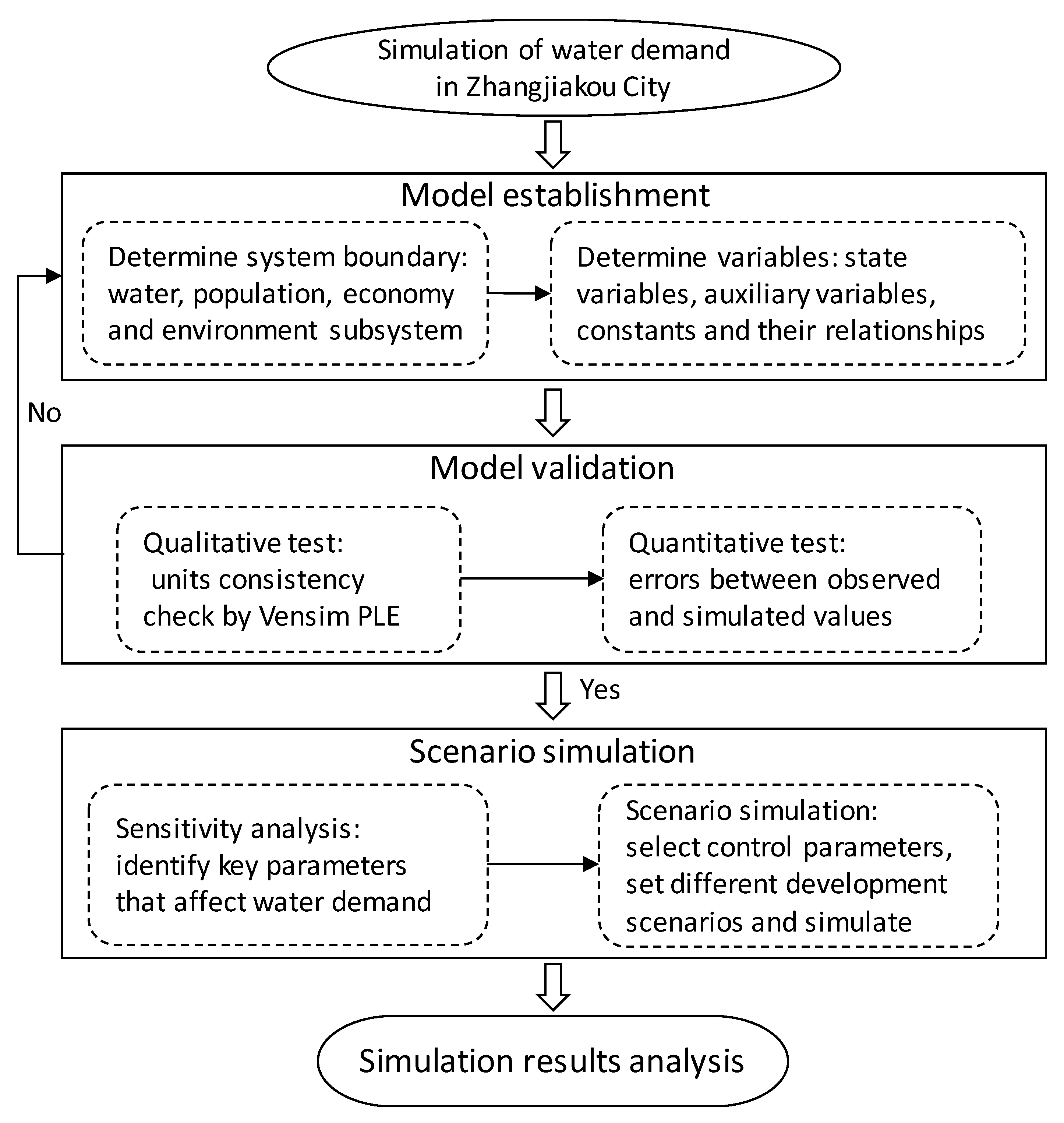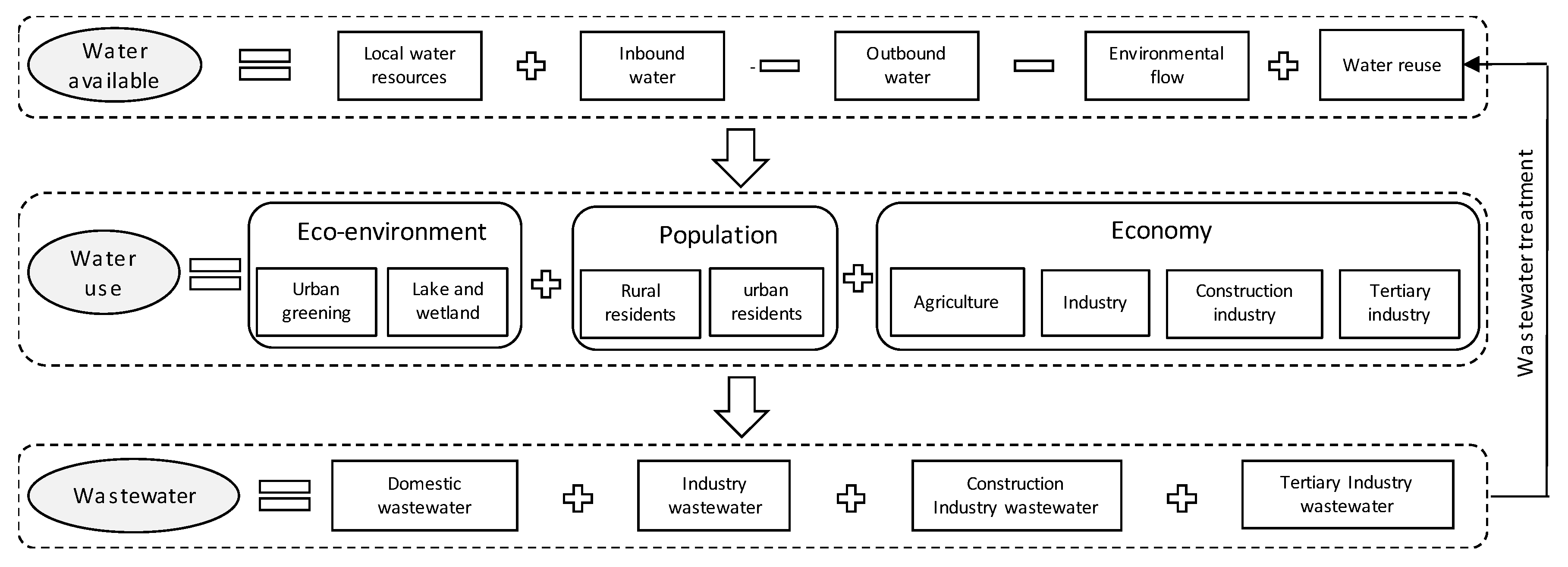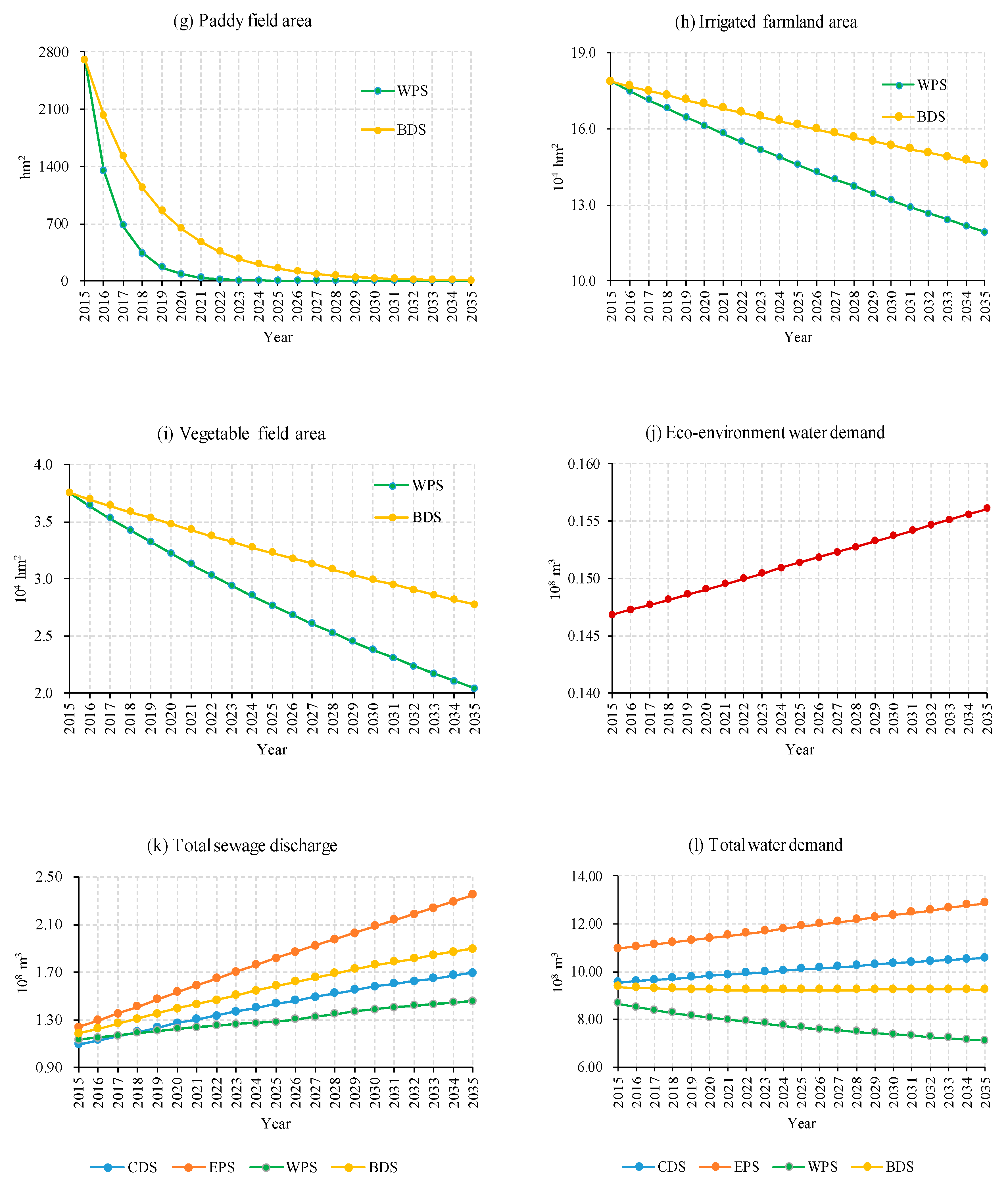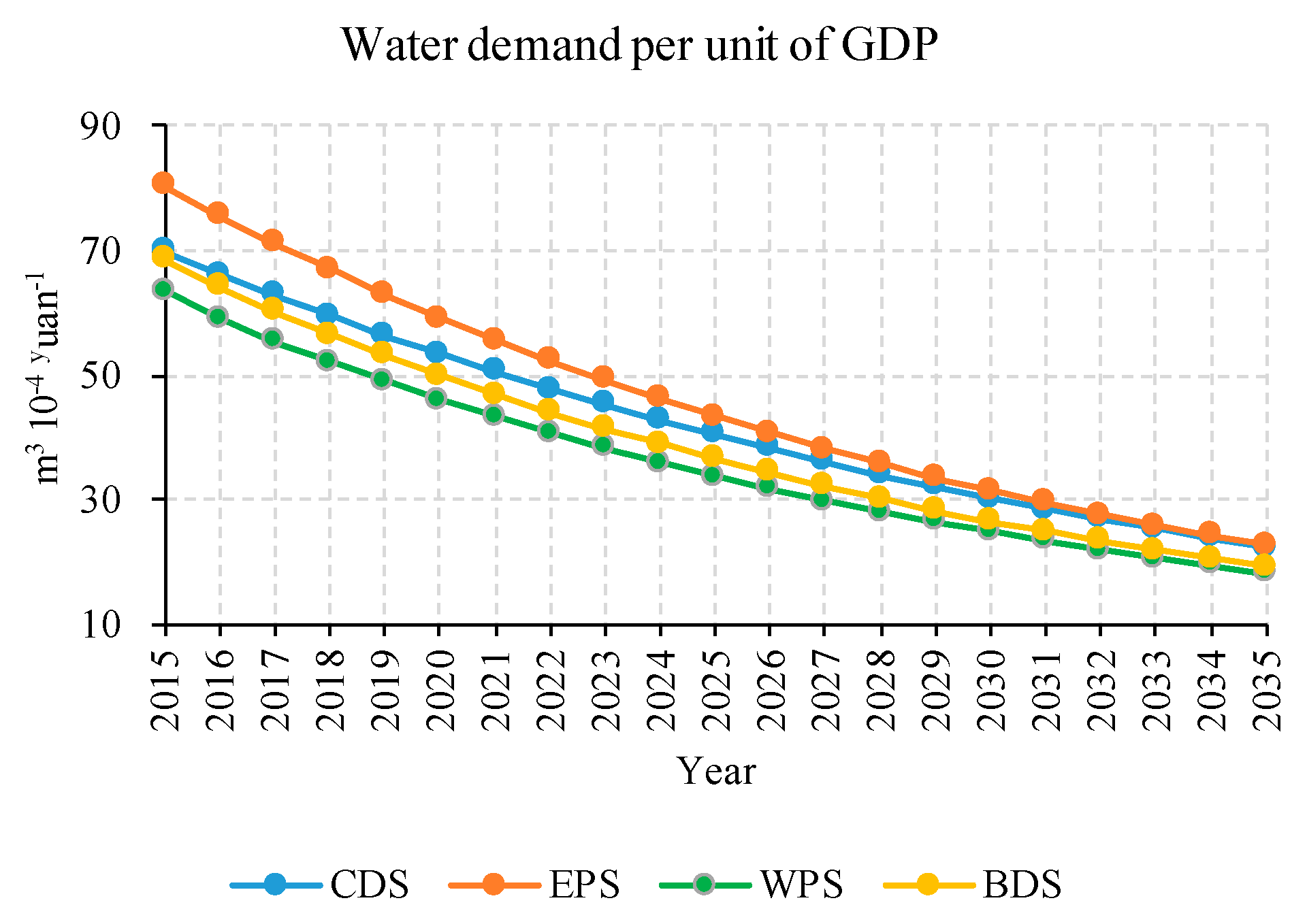Sensitive Factors Identification and Scenario Simulation of Water Demand in the Arid Agricultural Area Based on the Socio-Economic-Environment Nexus
Abstract
:1. Introduction
2. Study Area and Data Sources
2.1. Study Area
2.2. Data Sources
3. Methodology
3.1. System Dynamics Simulation
3.2. Zhangjiakou System Dynamics Model
3.2.1. Water Use Structure
3.2.2. Establishment of Model
3.3. Model Evaluation and Sensitive Factors Identification
3.3.1. Model Evaluation
3.3.2. Sensitive Factors Identification
3.4. Water Stress Index (WSI)
4. Results
4.1. Model Validation
4.2. Sensitivity Analysis
4.3. Scenarios Simulation
4.3.1. Scenarios Setting
4.3.2. Simulation Results
4.3.3. Water Stress Index
5. Discussion
5.1. Comparison with the “Two Zones Planning”
5.2. Policy Suggestions for Sustainable Water Use
5.3. Limitations of This Study
6. Conclusions
Supplementary Materials
Author Contributions
Funding
Acknowledgments
Conflicts of Interest
References
- Srinivasan, V.; Seto, K.C.; Emerson, R.; Gorelick, S.M. The impact of urbanization on water vulnerability: A coupled human–environment system approach for Chennai, India. Glob. Environ. Chang. 2013, 23, 229–239. [Google Scholar] [CrossRef]
- Winz, I.; Brierley, G.; Trowsdale, S. The Use of System Dynamics Simulation in Water Resources Management. Water Resour. Manag. 2008, 23, 1301–1323. [Google Scholar] [CrossRef]
- Yang, D.; Gao, X.; Xu, L.; Guo, Q. Constraint-adaptation challenges and resilience transitions of the industry–environmental system in a resource-dependent city. Resour. Conserv. Recycl. 2018, 134, 196–205. [Google Scholar] [CrossRef]
- Jiang, Y. China’s water security: Current status, emerging challenges and future prospects. Environ. Sci. Policy 2015, 54, 106–125. [Google Scholar] [CrossRef]
- Brown, C.M.; Lund, J.R.; Cai, X.; Reed, P.M.; Zagona, E.A.; Ostfeld, A.; Hall, J.; Characklis, G.W.; Yu, W.; Brekke, L. The future of water resources systems analysis: Toward a scientific framework for sustainable water management. Water Resour. Res. 2015, 51, 6110–6124. [Google Scholar] [CrossRef]
- Kotir, J.H.; Smith, C.; Brown, G.; Marshall, N.; Johnstone, R. A system dynamics simulation model for sustainable water resources management and agricultural development in the Volta River Basin, Ghana. Sci. Total Environ. 2016, 573, 444–457. [Google Scholar] [CrossRef] [PubMed]
- Yang, D.; Cai, J.; Hull, V.; Wang, K.; Tsang, Y.P.; Liu, J. New road for telecoupling global prosperity and ecological sustainability. Ecosyst. Health Sustain. 2017, 2. [Google Scholar] [CrossRef] [Green Version]
- Zhang, P.; Zou, Z.; Liu, G.; Feng, C.; Liang, S.; Xu, M. Socioeconomic drivers of water use in China during 2002–2017. Resour. Conserv. Recycl. 2020, 154. [Google Scholar] [CrossRef]
- Sun, Y.; Liu, N.; Shang, J.; Zhang, J. Sustainable utilization of water resources in China: A system dynamics model. J. Clean. Prod. 2017, 142, 613–625. [Google Scholar] [CrossRef]
- Döll, P.; Fiedler, K. Global-scale modeling of groundwater recharge. Hydrol. Earth Syst. Sci. 2008, 12, 863–885. [Google Scholar] [CrossRef] [Green Version]
- David, R.B.; Tobin, G.A. Understanding water policy sustainability: A case study in San Francisco and San Jose California. Environ. Sci. Policy 2017, 78, 167–172. [Google Scholar] [CrossRef]
- Larson, K.L.; White, D.D.; Gober, P.; Harlan, S.; Wutich, A. Divergent perspectives on water resource sustainability in a public–policy–science context. Environ. Sci. Policy 2009, 12, 1012–1023. [Google Scholar] [CrossRef]
- Hagemann, S.; Chen, C.; Clark, D.B.; Folwell, S.; Gosling, S.N.; Haddeland, I.; Hanasaki, N.; Heinke, J.; Ludwig, F.; Voss, F.; et al. Climate change impact on available water resources obtained using multiple global climate and hydrology models. Earth Syst. Dyn. 2013, 4, 129–144. [Google Scholar] [CrossRef] [Green Version]
- Shahadany, S.H.; Firoozfar, A.; Maestre, J.M.; Mallakpour, I.; Taghvaeian, S.; Karimi, P. Operational performance improvements in irrigation canals to overcome groundwaterr overexploitation. Agric. Water Manag. 2018, 204, 234–246. [Google Scholar] [CrossRef]
- Zhang, Q. The South-to-North Water Transfer Project of China: Environmental Implications and Monitoring Strategy. JAWRA J. Am. Water Resour. Assoc. 2009, 45, 1238–1247. [Google Scholar] [CrossRef]
- Sullivan, C. Calculating a water poverty index. World Dev. 2002, 30, 1195–1210. [Google Scholar] [CrossRef]
- Jemmali, H. Water Poverty in Africa: A Review and Synthesis of Issues, Potentials, and Policy Implications. Soc. Indic. Res. 2018, 136, 335–358. [Google Scholar] [CrossRef]
- Jemmali, H.; Matoussi, M.S. A multidimensional analysis of water poverty at local scale: Application of improved water poverty index for Tunisia. Water Policy 2013, 15, 98–115. [Google Scholar] [CrossRef] [Green Version]
- Jemmali, H.; Sullivan, C.A. Multidimensional Analysis of Water Poverty in MENA Region: An Empirical Comparison with Physical Indicators. Soc. Indic. Res. 2014, 115, 253–277. [Google Scholar] [CrossRef]
- Manandhar, S.; Pandey, V.P.; Kazama, F. Application of Water Poverty Index (WPI) in Nepalese Context: A Case Study of Kali Gandaki River Basin (KGRB). Water Resour. Manag. 2012, 26, 89–107. [Google Scholar] [CrossRef]
- Van Ty, T.; Sunada, K.; Ichikawa, Y.; Oishi, S. Evaluation of the state of water resources using Modified Water Poverty Index: A case study in the Srepok River basin, Vietnam—Cambodia. Int. J. River Basin Manag. 2010, 8, 305–317. [Google Scholar] [CrossRef]
- Han, Y.P.; Ruan, B.Q. Study on Water Resources Pressure of Regional Development in China. J. Sichuan Teach. Coll. Nat. Sci. 2002, 23, 219–224. [Google Scholar] [CrossRef]
- Naimi Ait-Aoudia, M.; Berezowska-Azzag, E. Water resources carrying capacity assessment: The case of Algeria’s capital city. Habitat Int. 2016, 58, 51–58. [Google Scholar] [CrossRef]
- Ren, C.; Guo, P.; Li, M.; Li, R. An innovative method for water resources carrying capacity research--Metabolic theory of regional water resources. J. Environ. Manag. 2016, 167, 139–146. [Google Scholar] [CrossRef]
- Yang, J.F.; Lei, K.; Khu, S.; Meng, W. Assessment of Water Resources Carrying Capacity for Sustainable Development Based on a System Dynamics Model: A Case Study of Tieling City, China. Water Resour. Manag. 2015, 29, 885–899. [Google Scholar] [CrossRef]
- Li, N.; Yang, H.; Wang, L.C.; Huang, X.J.; Zeng, C.F.; Wu, H.; Ma, X.X.; Song, X.T.; Wei, Y.N. Optimization of industry structure based on water environmental carrying capacity under uncertainty of the Huai River Basin within Shandong Province, China. J. Clean. Prod. 2016, 112, 4594–4604. [Google Scholar] [CrossRef]
- Choi, S.; Lee, S.O.; Park, J. A comprehensive index for stream depletion in coupled human-water systems. J. Hydro-Environ. Res. 2017, 16, 58–70. [Google Scholar] [CrossRef]
- Blair, P.; Buytaert, W. Socio-hydrological modelling: A review asking “why, what and how?”. Hydrol. Earth Syst. Sci. 2016, 20, 443–478. [Google Scholar] [CrossRef] [Green Version]
- Ghodsvali, M.; Krishnamurthy, S.; de Vries, B. Review of transdisciplinary approaches to food-water-energy nexus: A guide towards sustainable development. Environ. Sci. Policy 2019, 101, 266–278. [Google Scholar] [CrossRef]
- Duran-Encalada, J.A.; Paucar-Caceres, A.; Bandala, E.R.; Wright, G.H. The impact of global climate change on water quantity and quality: A system dynamics approach to the US–Mexican transborder region. Eur. J. Oper. Res. 2017, 256, 567–581. [Google Scholar] [CrossRef] [Green Version]
- Fang, C.; Cui, X.; Li, G.; Bao, C.; Wang, Z.; Ma, H.; Sun, S.; Liu, H.; Luo, K.; Ren, Y. Modeling regional sustainable development scenarios using the Urbanization and Eco-environment Coupler: Case study of Beijing-Tianjin-Hebei urban agglomeration, China. Sci. Total Environ. 2019, 689, 820–830. [Google Scholar] [CrossRef]
- Ghashghaie, M.; Marofi, S.; Marofi, H. Using System Dynamics Method to Determine the Effect of Water Demand Priorities on Downstream Flow. Water Resour. Manag. 2014, 28, 5055–5072. [Google Scholar] [CrossRef]
- Forrester, J.W. Industrial Dynamics: A major breakthrough for decision makers. Harv. Bus. Rev. 1958, 36, 37–66. [Google Scholar]
- Zomorodian, M.; Lai, S.H.; Homayounfar, M.; Ibrahim, S.; Fatemi, S.E.; El-Shafie, A. The state-of-the-art system dynamics application in integrated water resources modeling. J. Environ. Manag. 2018, 227, 294–304. [Google Scholar] [CrossRef] [PubMed]
- Teegavarapu, R.S.V.; Simonovic, S.P. Simulation of Multiple Hydropower Reservoir Operations Using System Dynamics Approach. Water Resour. Manag. 2014, 28, 1937–1958. [Google Scholar] [CrossRef]
- Safavi, H.R.; Darzi, F.; Mariño, M.A. Simulation-Optimization Modeling of Conjunctive Use of Surface Water and Groundwater. Water Resour. Manag. 2009, 24, 1965–1988. [Google Scholar] [CrossRef]
- Hoekema, D.J.; Sridhar, V. A System Dynamics Model for Conjunctive Management of Water Resources in the Snake River Basin. JAWRA J. Am. Water Resour. Assoc. 2013, 49, 1327–1350. [Google Scholar] [CrossRef]
- Qi, C.; Chang, N.B. System dynamics modeling for municipal water demand estimation in an urban region under uncertain economic impacts. J. Environ. Manag. 2011, 92, 1628–1641. [Google Scholar] [CrossRef]
- Gao, W.; Hong, B.; Swaney, D.P.; Howarth, R.W.; Guo, H. A system dynamics model for managing regional N inputs from human activities. Ecol. Model. 2016, 322, 82–91. [Google Scholar] [CrossRef]
- Jeong, H.; Adamowski, J. A system dynamics based socio-hydrological model for agricultural wastewater reuse at the watershed scale. Agric. Water Manag. 2016, 171, 89–107. [Google Scholar] [CrossRef]
- Liu, H.; Benoit, G.; Liu, T.; Liu, Y.; Guo, H. An integrated system dynamics model developed for managing lake water quality at the watershed scale. J. Environ. Manag. 2015, 155, 11–23. [Google Scholar] [CrossRef]
- Sahin, O.; Stewart, R.A.; Porter, M.G. Water security through scarcity pricing and reverse osmosis: A system dynamics approach. J. Clean. Prod. 2015, 88, 160–171. [Google Scholar] [CrossRef] [Green Version]
- Susnik, J.; Vamvakeridou-Lyroudia, L.S.; Savic, D.A.; Kapelan, Z. Integrated System Dynamics Modelling for water scarcity assessment: Case study of the Kairouan region. Sci. Total Environ. 2012, 440, 290–306. [Google Scholar] [CrossRef]
- Wei, T.; Lou, I.; Yang, Z.; Li, Y. A system dynamics urban water management model for Macau, China. J. Environ. Sci. 2016, 50, 117–126. [Google Scholar] [CrossRef] [Green Version]
- Kelly, C.; Onat, N.C.; Tatari, O. Water and carbon footprint reduction potential of renewable energy in the United States: A policy analysis using system dynamics. J. Clean. Prod. 2019, 228, 910–926. [Google Scholar] [CrossRef]
- The People’s Government of Zhangjiakou City. Zhangjiakou Economic Year Book; China Statistics Press: Beijing, China, 2006–2016. [Google Scholar]
- Zhangjiakou Water Resource Bureau. Zhangjiakou Water Resource Bulletin; Zhangjiakou Water Resource Bureau: Zhangjiakou, China, 2006–2016. [Google Scholar]
- Li, T.; Yang, S.; Tan, M. Simulation and optimization of water supply and demand balance in Shenzhen: A system dynamics approach. J. Clean. Prod. 2019, 207, 882–893. [Google Scholar] [CrossRef]
- Wei, S.; Yang, H.; Song, J.; Abbaspour, K.C.; Xu, Z. System dynamics simulation model for assessing socio-economic impacts of different levels of environmental flow allocation in the Weihe River Basin, China. Eur. J. Oper. Res. 2012, 221, 248–262. [Google Scholar] [CrossRef]









| Farmland Type | Area (hm2) | Water Use | Water Consumption per Unit Area (m3/hm2) | |
|---|---|---|---|---|
| Water Use (108 m3) | Percentage of Total Water Use (%) | |||
| Paddy field | 2733 | 0.15 | 2% | 5535 |
| Irrigated land | 178,467 | 4.98 | 53% | 2790 |
| Vegetable field | 37,533 | 1.29 | 14% | 3450 |
| Variables | 2010 | 2015 | ||||
|---|---|---|---|---|---|---|
| Simulated Value | Observed Value | ARE | Simulated Value | Observed Value | ARE | |
| Total population (104 persons) | 462 | 466 | 0.9% | 474 | 469 | 1.0% |
| Rural population (104 persons) | 309 | 314 | 1.4% | 303 | 298 | 1.6% |
| Urban population (104 persons) | 152 | 152 | 0.2% | 171 | 171 | 0.1% |
| Total GDP (108 yuan) | 961.3 | 966.4 | 0.5% | 1495.3 | 1363.5 | 9.7% |
| Agricultural GDP (108 yuan) | 143.1 | 152.9 | 6.4% | 250.2 | 243.7 | 2.7% |
| Secondary industry GDP (108 yuan) | 399.3 | 415.2 | 3.8% | 655.2 | 545.6 | 20.1% |
| Industrial GDP (108 Yuan) | 338.9 | 352.5 | 3.9% | 544.1 | 441.7 | 23.2% |
| Construction industry GDP (108 yuan) | 60.5 | 62.7 | 3.6% | 111.1 | 104.9 | 5.9% |
| Tertiary industry GDP (108 yuan) | 418.8 | 398.3 | 5.1% | 589.8 | 574.3 | 2.7% |
| Domestic water demand (108 m3) | 0.8132 | 0.8144 | 0.2% | 1.0435 | 1.0323 | 1.1% |
| Rural domestic water demand (108 m3) | 0.4405 | 0.4426 | 0.5% | 0.4647 | 0.4583 | 1.4% |
| Urban domestic water demand (108 m3) | 0.3727 | 0.3718 | 0.2% | 0.5788 | 0.5768 | 0.4% |
| Agriculture water demand (108 m3) | 8.2422 | 8.2465 | 0.1% | 7.0342 | 7.0282 | 0.1% |
| Industrial water demand (108 m3) | 1.2031 | 1.2500 | 3.8% | 1.0882 | 1.0074 | 8.0% |
| Construction water demand (108 m3) | 0.0357 | 0.0372 | 4.1% | 0.0255 | 0.0244 | 4.7% |
| Tertiary water demand (108 m3) | 0.0712 | 0.0683 | 4.2% | 0.1475 | 0.1455 | 1.3% |
| Environment water demand (108 m3) | 0.0623 | 0.0628 | 0.7% | 0.1483 | 0.1469 | 0.9% |
| Urban public water demand (108 m3) | 0.1069 | 0.1056 | 1.2% | 0.1730 | 0.1699 | 1.8% |
| Total water demand (108 m3) | 10.4276 | 10.4794 | 0.5% | 9.4872 | 9.3848 | 1.1% |
| Total wastewater discharge (108 m3) | 0.8228 | 0.8420 | 2.3% | 0.9862 | 0.9357 | 5.4% |
| Variables | Units | Time | CDS | EPS | WPS | BDS |
|---|---|---|---|---|---|---|
| Per capita water quota of urban residents | L/person/day | – | 93 | 120 | 100 | 110 |
| Per capita water quota of rural residents | L/person/day | – | 42 | 60 | 50 | 60 |
| Industrial growth rate | % | – | 4.6 | 5.6 | 3.6 | 5.1 |
| Construction industry growth rate | % | – | 7.3 | 8.3 | 6.3 | 7.3 |
| Tertiary industry growth rate | % | – | 8.1 | 9.1 | 7.1 | 8.1 |
| Agriculture growth rate | % | – | 3.3 | 4.3 | 2.3 | 3.3 |
| Paddy field reduction rate | % | – | 0 | 0 | −50 | −25 |
| Irrigated land reduction rate | % | – | 0 | 0 | −2 | −1 |
| Irrigated land water quota | m3/ha | – | 2790 | 3240 | 2340 | 2565 |
| Vegetable field reduction rate | % | – | 0 | 0 | −3 | −1.5 |
| Vegetable field water quota | m3/ha | – | 3450 | 3900 | 3000 | 3150 |
| Number of large livestock | Million | – | 0.75 | 0.95 | 0.65 | 0.85 |
| Number of small livestock | Million | – | 11.59 | 13.59 | 10.59 | 12.59 |
| Urbanization rate | % | 2015 | 52 | 52 | 52 | 52 |
| 2020 | 60 | 62 | 58 | 60 | ||
| 2022 | 62 | 65 | 60 | 62 | ||
| 2025 | 65 | 68 | 62 | 65 | ||
| 2030 | 70 | 73 | 67 | 70 | ||
| 2035 | 72 | 75 | 69 | 72 | ||
| Per unit of industrial gross domestic product (GDP) water use | m3*10−4 yuan−1 | 2015 | 22.8 | 22.8 | 22.8 | 22.8 |
| 2025 | 18 | 20 | 15 | 18 | ||
| 2035 | 12 | 15 | 10 | 12 |
© 2020 by the authors. Licensee MDPI, Basel, Switzerland. This article is an open access article distributed under the terms and conditions of the Creative Commons Attribution (CC BY) license (http://creativecommons.org/licenses/by/4.0/).
Share and Cite
Ma, W.; Meng, L.; Wei, F.; Opp, C.; Yang, D. Sensitive Factors Identification and Scenario Simulation of Water Demand in the Arid Agricultural Area Based on the Socio-Economic-Environment Nexus. Sustainability 2020, 12, 3996. https://doi.org/10.3390/su12103996
Ma W, Meng L, Wei F, Opp C, Yang D. Sensitive Factors Identification and Scenario Simulation of Water Demand in the Arid Agricultural Area Based on the Socio-Economic-Environment Nexus. Sustainability. 2020; 12(10):3996. https://doi.org/10.3390/su12103996
Chicago/Turabian StyleMa, Weijing, Lihong Meng, Feili Wei, Christian Opp, and Dewei Yang. 2020. "Sensitive Factors Identification and Scenario Simulation of Water Demand in the Arid Agricultural Area Based on the Socio-Economic-Environment Nexus" Sustainability 12, no. 10: 3996. https://doi.org/10.3390/su12103996





